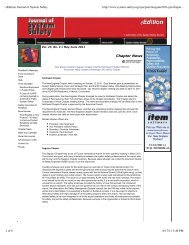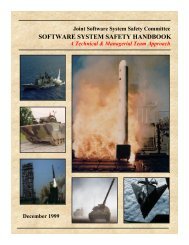Air Force System Safety Handbook - System Safety Society
Air Force System Safety Handbook - System Safety Society
Air Force System Safety Handbook - System Safety Society
You also want an ePaper? Increase the reach of your titles
YUMPU automatically turns print PDFs into web optimized ePapers that Google loves.
of effort necessary to effectively accomplish the contractual<br />
task. It is helpful to the evaluator if this section contains a<br />
matrix identifying applicable proposal sections which have<br />
been allotted resources to implement the system safety task<br />
and describes how these<br />
resources are controlled by the system safety manager. The<br />
referenced proposal task should describe how the system<br />
safetytasks associated with the function will be implemented<br />
and monitored. (37:3-10)<br />
For management purposes, with the listing of each document<br />
applicable to the system safety effort, list those functions<br />
within the contractor’s organization which have the responsibility<br />
for assuring that the requirements in each compliance<br />
document are met. . Those responsible for using, implementing<br />
the information in applicable documents, or complying<br />
with their provisions must be clearly identified for effective<br />
planning. (37:3-10)<br />
5.3 <strong>System</strong> <strong>Safety</strong> Organization.<br />
(30:102-1)<br />
The SSPP describes:<br />
a. The system safety organization or function within<br />
the organization of the total program using charts to<br />
show the organizational and functional relationships<br />
and lines of communication.<br />
b. The responsibility and authority of system safety<br />
personnel, other contractor organizational elements<br />
involved in the system safety effort, subcontractors,<br />
and system safety groups. Identify the<br />
organizational unit responsible for executing each<br />
task. Identify the authority in regard to resolution of<br />
all identified hazards. Include the name, address,<br />
and telephone number of the system safety program<br />
manager.<br />
c. The staffing of the system safety organization for the<br />
duration of the contract to include manpower<br />
loading, control of resources, and the qualifications<br />
of key system safety personnel assigned, including<br />
those who possess coordination/approval authority<br />
for contractor-prepared documentation.<br />
d. The procedures by which the contractor will<br />
integrate and coordinate the system safety efforts,<br />
including assignment of the system safety requirements<br />
to action organizations and subcontractors,<br />
coordination of subcontractor system safety programs,<br />
integration of hazard analyses, program and<br />
design reviews, program status reporting, and<br />
system safety groups.<br />
e. The process through which contractor management<br />
decisions will be made, including timely notification<br />
of unacceptable risks, necessary action, mishaps or<br />
malfunctions, waivers to safety requirements,<br />
program deviations, etc. (30:102-2)<br />
Internal control for the proper implementation of system safety<br />
requirements and criteria affecting hardware, operational<br />
resources, and personnel are the responsibility of the system<br />
safety managers through their interface with other program<br />
disciplines. The program system safety manager is<br />
responsible for initiation of required action whenever internal<br />
coordination of controls fail in the resolution of problems.<br />
<strong>System</strong> safety responsibilities are an inherent part of every<br />
program function and task. Resolution and action relating to<br />
system safety matters will be affected at the organizational<br />
level possessing resolution authority. For this reason, the<br />
41<br />
system safety program must be integrated into the total<br />
management and engineering effort. The contractor must<br />
provide a description of a system safety function with<br />
centralized mishap risk management authority, as the agent of<br />
the program manager, to maintain a continuous overview of<br />
the technical and planning aspects of the total program. While<br />
the specific organizational assignment of this function is a<br />
bidders’ responsibility, to be acceptable the plan must show a<br />
direct accountability to the program manager with unrestricted<br />
access to any level of management. (37:3-10 to 3-11)<br />
The program directors are responsible for all decisions relating<br />
to the conduct and implementation of their system safety<br />
program; it is expected that they will hold each element<br />
manager fully accountable for the implementation of safety<br />
requirements in their respective area of responsibility. The<br />
system safety manager must be responsible to the program<br />
director for the implementation of the total mishap prevention<br />
program. (37:3-11)<br />
In the normal performance of their duties, system safety<br />
program managers must have direct approval authority over<br />
any safety-critical program documentation, design,<br />
procedures, or procedural operation or rejection if it does not<br />
meet minimum safety standards. A log of nondeliverable data<br />
can be maintained showing all program documentation<br />
reviewed, concurrence or nonoccurrence, reasons why the<br />
system safety engineer concurs or nonconcurs and actions<br />
taken as a result of nonoccurrence. The program office<br />
system safety manager should periodically review this log to<br />
monitor program progress. The task breakdown and manning<br />
necessary to support the program through the term of the<br />
contract will be contained in this section. For full application of<br />
the MIL-Standard program, including integration tasks, it is<br />
expected that contractor hours assigned for the system safety<br />
task could be within a range of 5 to 7 percent of engineering<br />
resources assigned to the program. More or less time will be<br />
required depending upon system complexity and how the<br />
standard is tailored. The contractor is required to assign a<br />
system safety manager who meets specific educational and<br />
professional requirements and who has had significant, full-time<br />
assignments in the professional practice of system safety.<br />
For major programs, consider (it’s not absolute) a registered<br />
professional engineer with no less than 6 years of full-time<br />
assignments in the implementation of system safety programs<br />
or functional tasks. On approval of the contractor’s specific<br />
request, 3 additional years of full-time assignments may be<br />
substituted for educational requirements. Substitution of the<br />
professional recognition is acceptable providing equivalent<br />
professional recognition shown such as recognition by the<br />
Board of Certified <strong>Safety</strong> Professionals as a Certified <strong>System</strong><br />
<strong>Safety</strong> professional. In any case, assignment as a contractor<br />
system safety manager requires significant system safety<br />
experience. (37:3-11)<br />
5.4 Program Milestones.<br />
The SSPP should:<br />
a. Define system safety program milestones.<br />
b. Provide a program schedule of safety tasks,<br />
including start and completion dates, reports,<br />
reviews, and estimated manpower loading.<br />
c. Identify integrated system safety activities (i.e.,<br />
design analysis, tests, and demonstration)<br />
applicable to the system safety program but<br />
specified in other engineering studies to preclude<br />
duplication. Included in this section shall be the<br />
estimated manpower to do these tasks. (30:102-2)




